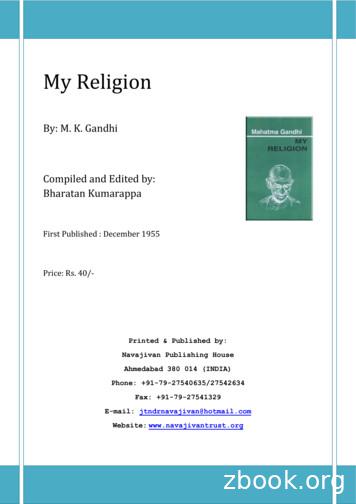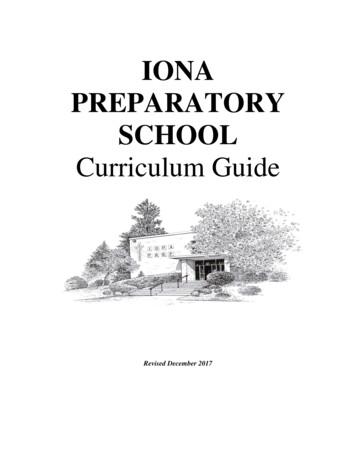Chapter 11 Religion And Reform, 1800-1860
Chapter 11Religion and Reform,1800-1860APUSH – Mr. Muller
Aim: How is American societychanging in the Antebellumperiod?Do Now: “We would have every path laid open to Woman asfreely as to Man As the friend of the Negro assumes thatone man cannot by right hold another in bondage, so shouldthe friend of Woman assume that Man cannot by right layeven well-meant restrictions on Woman.”-Margaret Fuller, 1845
Big Idea The Second Great Awakening, liberal social ideas fromabroad, and Romantic beliefs in human perfectibilityfostered the rise of voluntary organizations to promotereligious and secular reforms, including abolition andwomen’s rights. Various groups of American Indians, women, and religiousfollowers developed cultures reflecting their interests andexperiences, as did regional groups and an emerging urbanmiddle class.
NEW IDEAS: Liberalism in ReligionDEISM Less revelation, more reliance on reason Less Bible, more science But they believe in God– Gave human beings capacity for moral behaviorUNITARIANISM Spinoff from less extreme Puritanism of the past Humans have free will and the possibility of salvation by good works– God not as stern Creator, but loving father Contrast with hellfire doctrines of Calvinism– Reject Predestination and human wickedness
Second Great AwakeningReasons: Concern over lack of religious zeal Ideas of Deism and UnitarianismWave of revivals spread across the country–Frontier “camp meetings”– Charles Finney- revival preacher who leads revivals in New York area in 1830s Against slavery and alcohol Numerous citizens converted– “Born again Christians”–Boosted church attendance New religious sects formed Methodists and Baptists huge increase in numbers Stressed personal conversion (not predestination) Democratic control of church affairs Emotionalism in worship
Second Great Awakening Increase in evangelicalism inspire reform efforts- Age of Reform– Prison Reform– Temperance– Women’s movement– Anti-slavery Key part of Second Great Awakening was the key role of women inreligion– Majority of new church members– Women role of bringing family back to God– Inspired involvement in various other reform efforts
Mormons Joseph Smith- Creates Church of Jesus Christ of Latter-Day Saints– Travels to Illinois– Murdered in 1844 Brigham Young leads the followers to Utah in 1846-47– Develops a separate community (“New Zion”)– Prosperous cooperative frontier community– Settlement increases by birthrate and immigrants from abroad(Missionary) Will not be admitted into the union until 1896– Issue of polygamy
The Age of Reform!
Dorothy Dix Dorothy Dix- worked tirelessly to reform mental health treatment Traveled the country to document the problem Leads to professional treatment for the mentally ill
Education Reform Tax supported schools were rare in early years of the republic Benefits of Public Education– Instill republican values– Instill values: discipline, hard work, etc.– Americanize immigrants Horace Mann- Secretary of Mass. Board of Education– Longer school terms– Compulsory attendance– Expanded curriculum– More schools North benefitted far more from education reforms– Illegal for black slaves to learn to read and write
Temperance Problems Drinking Problems– Factory system needed efficient labor– Family life– Seen as immigrant issue (Irish and Germany drinking) American Temperance Society created in 1826– Urged members to stop drinking– Created propaganda to spread their “dry” message Move from temperance to legal prohibition Maine Law of 1851– Prohibited the manufacture and sale of liquor– Nationwide with 18th Amendment
Women Resist Women were treated like second class citizens– Democratization did not apply to women– “Age of Common Man” “Cult of domesticity”– the home was a woman’s special sphere Idea of “republican motherhood”– Mothers should raise children to be good citizens
Women Resist Women Reformers:– Inspired by Second Great Awakening– Demand rights for women, temperance movement, and theabolition of slavery Lucretia Mott and Elizabeth Cady Stanton both advocated forsuffrage for women Women’s Rights: Seneca Falls Convention (1848)––––Stanton read “Declaration of Sentiments”“All men and women are created equal”Demand right to vote for womenLaunched the modern women’s rights movement Women’s rights was overshadowed by abolitionist movement
Transcendentalism Truth, “transcends” the senses– Not just found by observation alone Every person possess an inner light that can illuminate the highesttruth Ralph Waldo Emerson- stress self reliance, self improvement, andfreedom.– “The American Scholar” in 1837 at Harvard challenged Americans to maketheir own art and culture Henry David Thoreau- “On the Duty of Civil Disobedience” (1849)&“Walden”
Utopian Communities Various movements to move away from conventional society andcreate a utopian community. Mormons: religious communal effort Brook Farm: communal transcendentalist experiment in Mass.– Secular, humanistic New Harmony: create a socialist type community that would be ananswer to the problems presented by industrialization.
VOCABULARY UNDERGROUND RAILROAD:The secret way in which abolitionist (antislavery people) helped slaves escape from thesouth to the north
Escaping from slavery: the Underground RailroadNeither "underground" nor a "railroad," thisinformal system was a loosely constructednetwork of escape routes which originated inthe South, intertwined throughout the Northand eventually ended in Canada. Escape routeswere not just in the North, but also extendedinto Western territories, Mexico and theCaribbean. From 1830 to 1865, theUnderground Railroad reached its peak asabolitionists and sympathizers who condemnedslavery helped large numbers of slaves wintheir freedom. Workers on the UndergroundRailroad did more then speak out againstslavery they helped slaves get out of slavery.There was no formal organization. It reliedupon individuals cooperating to help theenslaved escape to freedom.18
s
Lucretia Mott and Elizabeth Cady Stanton both advocated for suffrage for women Women’s Rights: Seneca Falls Convention (1848) –Stanton read “Declaration of Sentiments” –“All men and women are created equal” –Demand right to vote for women –Launched the modern women’s rights movement
Part One: Heir of Ash Chapter 1 Chapter 2 Chapter 3 Chapter 4 Chapter 5 Chapter 6 Chapter 7 Chapter 8 Chapter 9 Chapter 10 Chapter 11 Chapter 12 Chapter 13 Chapter 14 Chapter 15 Chapter 16 Chapter 17 Chapter 18 Chapter 19 Chapter 20 Chapter 21 Chapter 22 Chapter 23 Chapter 24 Chapter 25 Chapter 26 Chapter 27 Chapter 28 Chapter 29 Chapter 30 .
TO KILL A MOCKINGBIRD. Contents Dedication Epigraph Part One Chapter 1 Chapter 2 Chapter 3 Chapter 4 Chapter 5 Chapter 6 Chapter 7 Chapter 8 Chapter 9 Chapter 10 Chapter 11 Part Two Chapter 12 Chapter 13 Chapter 14 Chapter 15 Chapter 16 Chapter 17 Chapter 18. Chapter 19 Chapter 20 Chapter 21 Chapter 22 Chapter 23 Chapter 24 Chapter 25 Chapter 26
DEDICATION PART ONE Chapter 1 Chapter 2 Chapter 3 Chapter 4 Chapter 5 Chapter 6 Chapter 7 Chapter 8 Chapter 9 Chapter 10 Chapter 11 PART TWO Chapter 12 Chapter 13 Chapter 14 Chapter 15 Chapter 16 Chapter 17 Chapter 18 Chapter 19 Chapter 20 Chapter 21 Chapter 22 Chapter 23 .
FAMILY AND RELIGIOUS STUDIES SYLLABUS (FORMS 1 – 4) 9 Religion and the Liberation Struggle-Chimurenga/Umvukela Religion, Rights and Social Responsibility Religion and Conflict management 7.0 SCOPE AND SEQUENCE 7.1 TOPIC 1: RELIGION SUB-TOPIC FOR M 1 FORM 2 FORM 3 FORM 4 Concept of Religion Definition, types and c haracteristics of religion Different religions in Zimbabwe .
religion. However, religion cannot be defined except by the characteristics by which are found wherever religion itself is found.4 Nevertheless, the one aspect of religion that must be agreed upon, and is required to remotely be considered as religion, is that it is a belief system held by a group of
Religion which takes no account of practical affairs and does not help to solve them, is no religion. Young India, 7-5-'25, p. 164 Every activity of a man of religion must be derived from his religion, because religion means being bound to God,
Religion in the Schools Task Force guided this initiative.6 Overview of Guidelines Part One addresses why it is important to teach about religion, and Part Two outlines ways to teach about religion in constitutionally sound ways. Part Three is an overview of approaches to teaching about religion
Curriculum Guide Revised December 2017. Course Offerings Department 9th 10th 11th 12th Religion Religion 1 Religion 2 Religion 3 Religion 4 Religion 4/ Leadership . Freshmen will become familiar with the Common Application to understand the elements considered by colleges for admission.






















